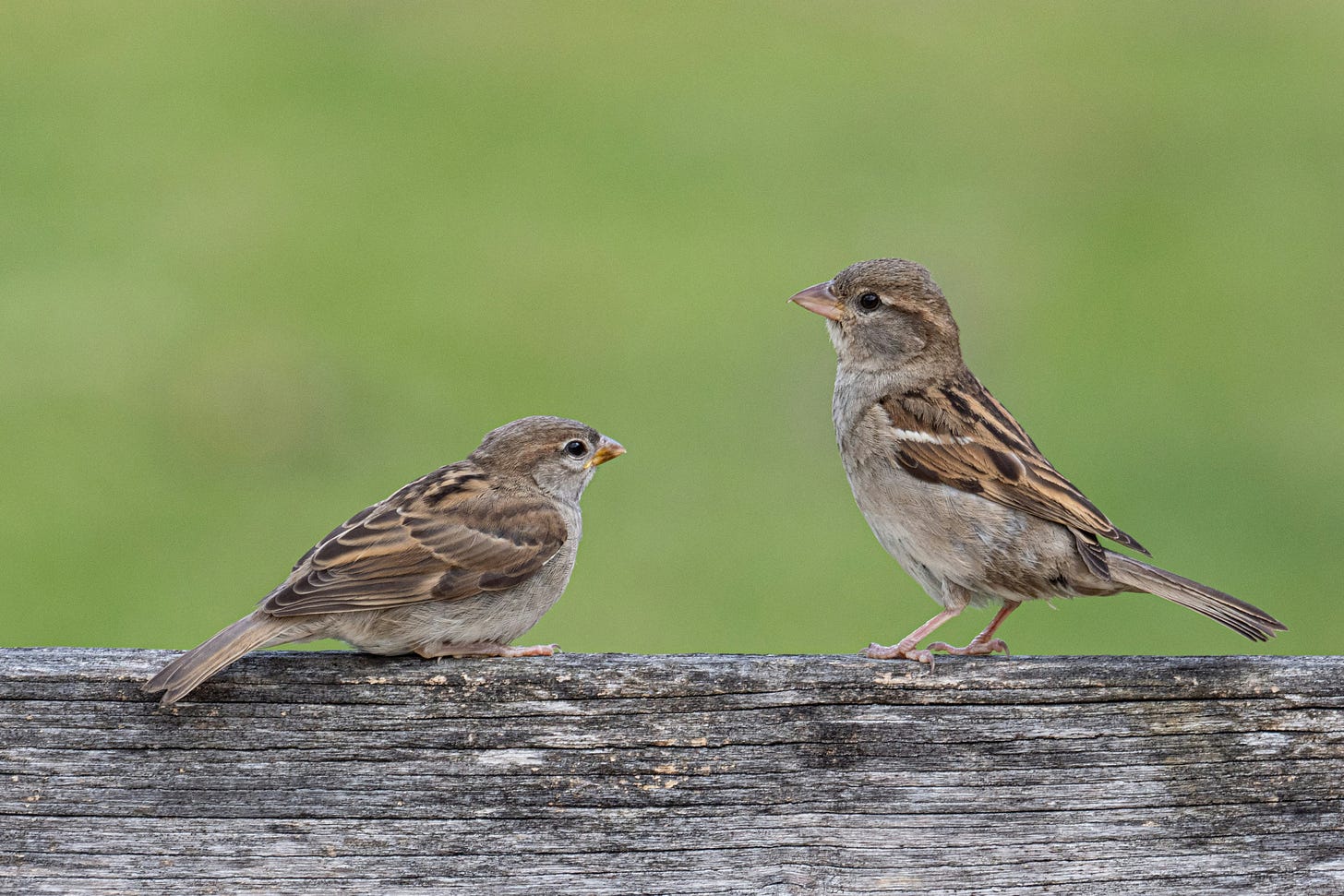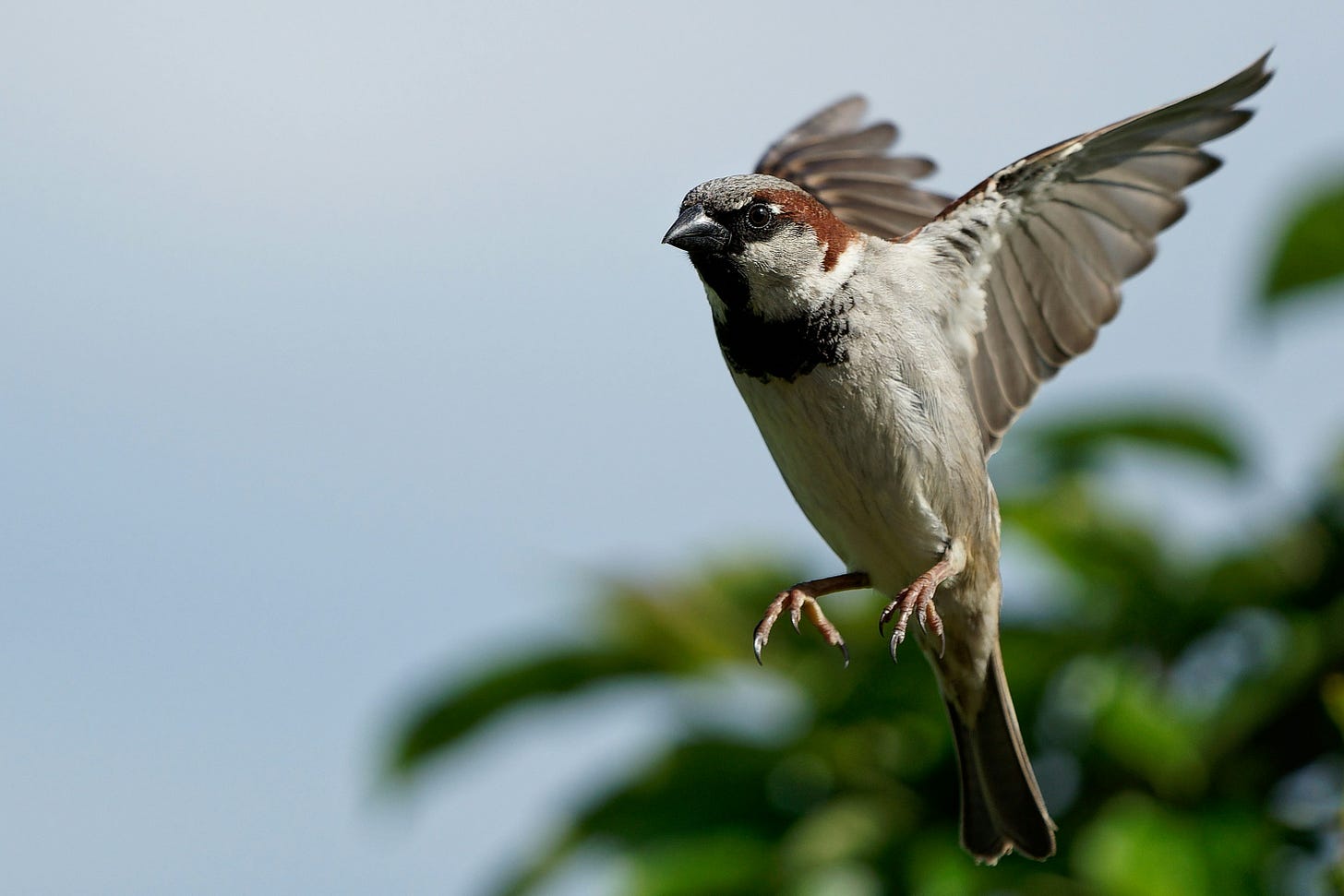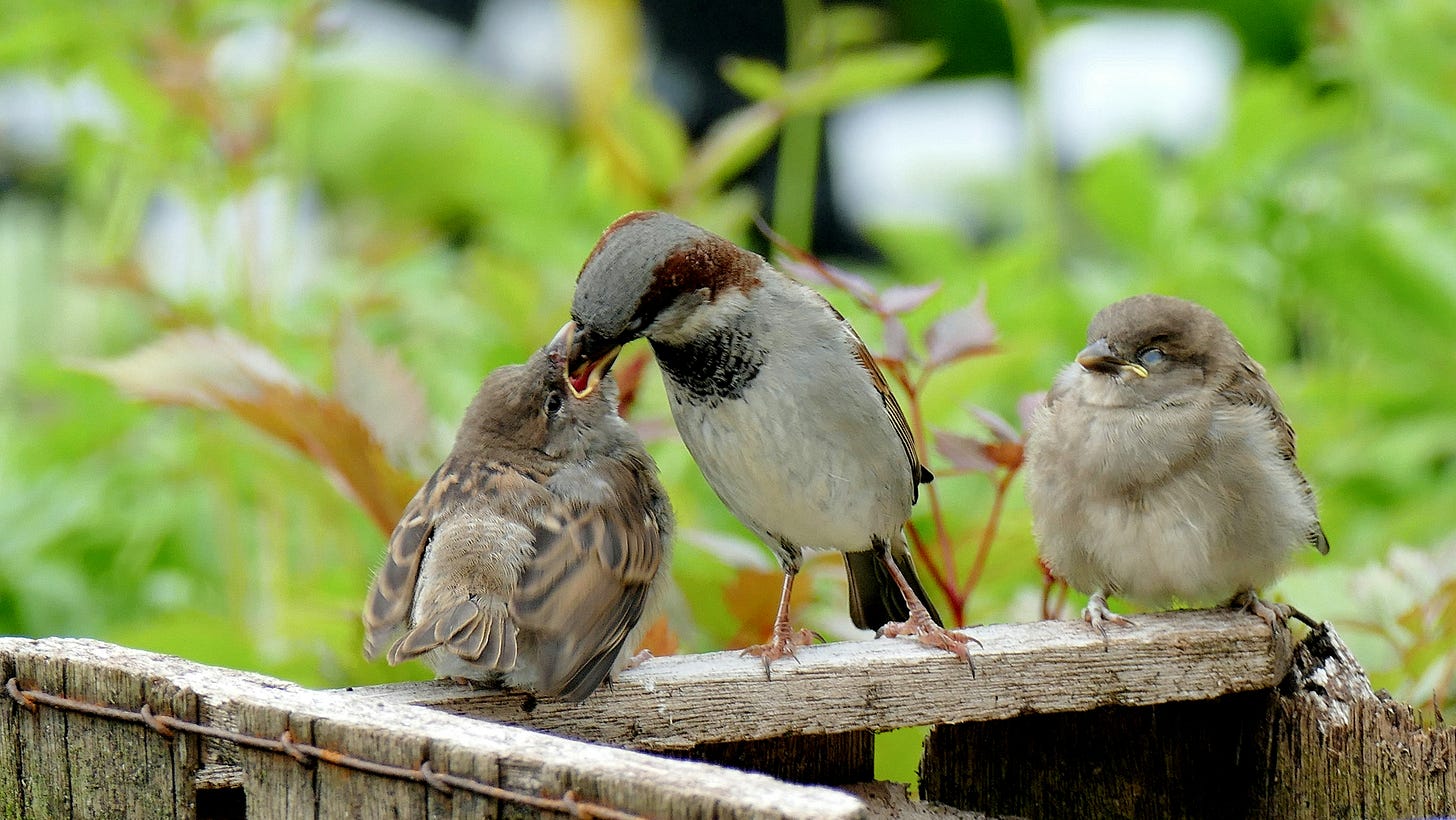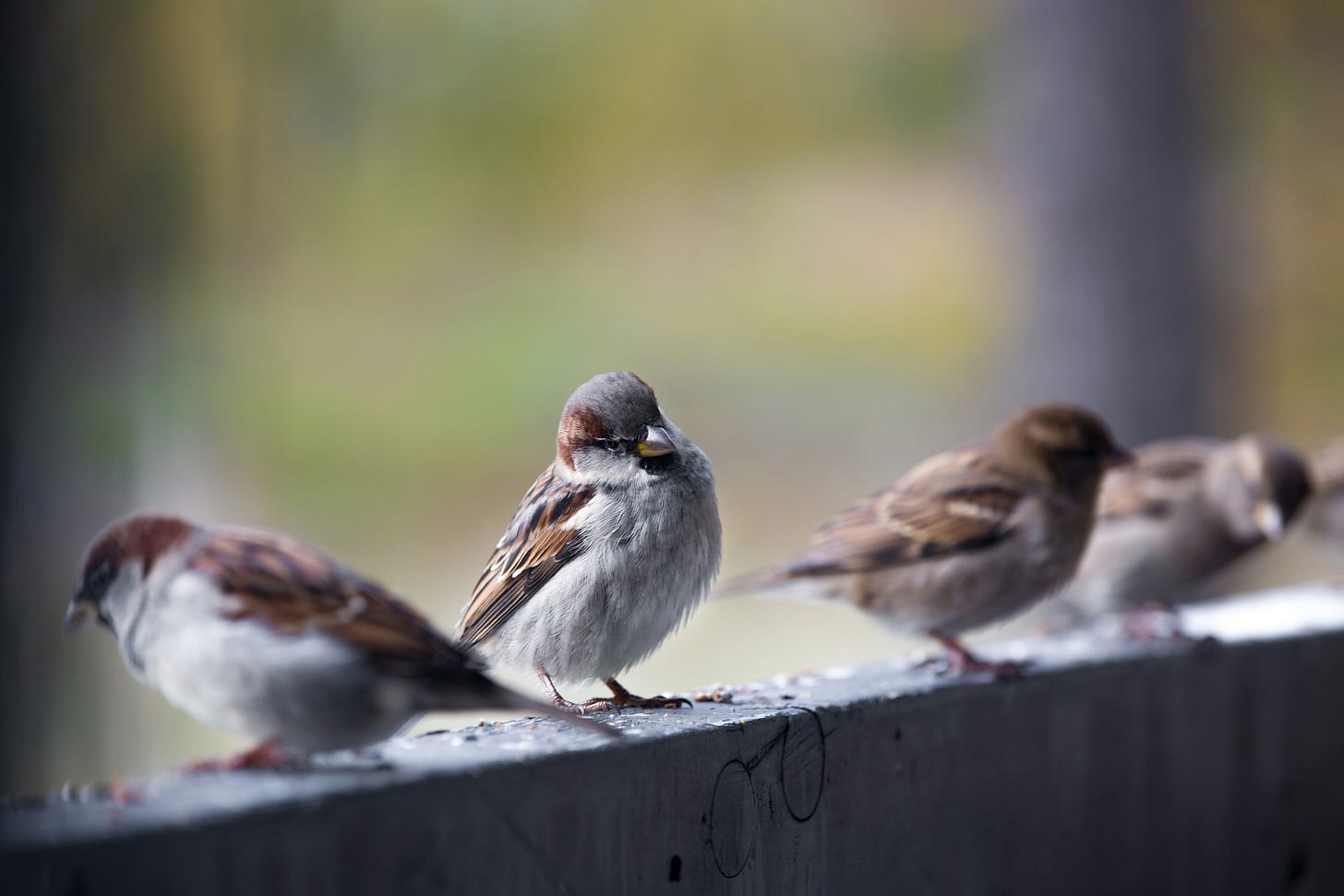
It was a perfect winters day. The sun shining through the trees, great tits calling loudly from the willows, cold nibbling at my nose as I pulled my woolly hat down over my ears. I thrust my glove covered hands deep into my pockets and took in a deep breath of fresh air. Maverick and Leo (my dogs) trotted along behind me as I approached the wildlife garden. Immediately, I could sense something was wrong. All the birds fluttered away long before I approached, but there was something out of place. Something brown was hanging from one of the feeders, a shallow mesh bowl suspended from the plum tree.
I pulled open the metal gate with a squeak and approached cautiously. My heart began to race as I got closer. The immobile brown object was a sparrow, hanging upside down by one claw. My stomach lurched. I knew it was trapped as soon as it began to struggle, unable to release itself from its unnatural hanging position. Despite its distress, I was relieved to see it move, at least it was still alive.
I knew I had to help it, but I didn’t want to risk scaring it and sending it into shock, which could result in death.

I have a huge admiration for sparrows. Those of you who see my notes will know that I have been enjoying their company on my daily dog walks for most of January. They gather in crowds in my hawthorn hedge, and chatter and flit from branch to branch, relatively unphased by my proximity. I often call a cheery ‘good morning’ to them and if I have time, I will stand to watch them for a while as they go about their business.
With a UK population of 5.3 million pairs, the house sparrow is now on the UK conservation red list, meaning they are in urgent need of conservation efforts to prevent their decline and potential extinction. This added even more urgency to my rescue mission!
But I do know there are no shortages of house sparrows in my garden. Each day, outside my kitchen window, I see sparrows queuing up in the crab apple tree, waiting for their turn at the bird feeder. But, unlike the polite long tailed tits I described in my recent article Midwinter Magic, they act more like squabbling siblings.
“Mine,’’ they seem to say “No, it’s mine.” “No mine, out of my way!”
They think nothing of barging each other out of the way, when it comes to tasty fat balls or sunflower seeds. Then later they will comfortably hang out as one big happy family, having group dust bathing sessions in any kind of suitable dirt they can find. A collective sparrow bath is a delight to see, water being thrown in all directions with abandon, like children in a paddling pool. I need to keep a close eye on the level of water in my bird bath when the sparrows get going.

I used to take them for granted, barely even noticing them. They were just dull backing singers to some of the more glamorous stars of the bird feeder. Like the glorious goldfinch, or the colourful chaffinch. But the longer I’ve spent as a homeowner with my very own bird feeder, the more I have learnt to appreciate their energy. They seem to be incredibly friendly, gregarious birds. There is no mistaking their presence as they can make quite the racket when they get together for a family gathering.
I love that the National History Museum describes them as ‘cheerful opportunists.’ I think this is a perfect description. (You can read about sparrows in more detail here) Their place in my heart as a courageous little bird was cemented when I discovered that they have been known to pluck feathers from live pigeons to line their nests with! Now that’s a cheeky bird.
Perhaps unsurprisingly, given their nature, sparrows have colonised most of the world, with the biggest range of any wild bird. I only recently discovered that house sparrows are not the only sparrow species in the UK. There is one other, the tree sparrow. They do look incredibly similar but can be distinguished by the black spot on each cheek of the tree sparrow, and the fact that the top of its head is brown rather than grey.
Although, despite their relative comfort in the presence of humans, they’ve never allowed me to get close enough to see them in that much detail. However, I suspect that the sparrows in my garden are all house sparrows. As they live in colonies of up to 40 birds, this explains all the noise in the hedgerow too!
I was a huge fan of reading Enid Blyton books as a child and I have never forgotten how her character ‘Pip’ in ‘The Adventures of Pip’, was asked to help the male sparrows to ‘dress in their best’ to attract their wives in spring. And so, Pip painted smart black bibs on each of the male sparrows. I’ve never forgotten this memorable way to know if a sparrow is male or female, and it turns out, that the black bibs do even more than that. According to Montana Natural History Centre:-
Males with the largest breast patch are highest in the pecking order. All of the sparrows know where they fall in this pecking order and the highest-ranking individual gets the safest feeding spots, has the largest breeding territory with more and better mates, and is first in line for food when food is scarce. Scientists are not sure what makes the breast patches bigger on some than on others, but they have found a positive correlation between the fighting ability of the male and the size of the patch.

Although nesting has been observed all year round, the main nesting season for house sparrows is from April to August. This is when the activity at my bird feeder increases. I will often hear the insistent calls of the young fledglings and go to the window to see what all the fuss is about. They will be sat close to a harassed looking parent, puffing up their feathers, looking like little vibrating balls of brown fluff, demanding their food with a loud ‘cheep’.
Often several chicks will surround the parent bird at the same time. The sparrow can lay up to seven eggs in a clutch, and the chicks are unable to feed themselves for a week after fledging, so these parents have their work cut out for them. I just discovered that it is the male that will continue to care for the chicks once they leave the nest, whilst the female prepares for the next brood. What a considerate mate!

So, how was I to approach my injured sparrow without upsetting it? A simple internet search confirmed that rough handling or a sudden scare can trigger a shock response, that the bird may be unable to recover from. It is suggested that you should only help if it seems unlikely the bird will survive on its own. Looking at this poor helpless creature, it was clear to me that intervention was needed.
I recently did a course in animal reiki, and so I decided to put my skills to the test. I tuned into the energy and focused it on flowing in a positive direction towards the little bird. It seemed to calm it a little, as it didn’t panic as I crept towards it.
I gently cupped both hands around its little body, whilst it remained quite still, and slowly, carefully, tipped it the right way up, then let go. Its claw released and it fluttered off, twittering its protest, but otherwise seemingly unharmed. What a relief.
It took a while for my heart rate to return to normal. I decided then and there that I could never have been a vet (despite my school aged self thinking this was a possible career choice). I seem to feel the animals panic as if it’s my own. But for that moment it felt good to do my bit, despite my racing heart. I left the wildlife garden and closed the gate, feeling incredibly grateful to those wonderful souls in the world whose job it is to heal the wounded.

The reiki came in handy though. In fact, it has enabled me to bring a sense of calm to several anxious birds in precarious situations over recent months. From a pigeon that had been attacked by a crow, to a blue tit that flew into the window of my greenhouse, knocking itself unconscious. I believe it helps to induce a state of calm in me, which means that I do not come across as quite as much of a threat to the bird. My husband, as the son of a pigeon fancier, is the sensible, measured one who can calmly pick up a bird when it is flapping and panicking. Then I come swooping in to bring the reiki. I like to think we make quite the team.
And so, my little sparrow lived to fight with his siblings another day. I’m sure it is out there now, squabbling and chattering amongst the brambles and the hawthorn. I wonder, as I pass the hedge on my daily walk, and call to say hello, if it recognises me. If some of that noisy chatter might be it saying to his companions, ‘That’s the woman who saved my life.’
I know that’s just my fanciful imagination of course, but it’s a nice thought…
How do you feel about sparrows? Do you see a lot of them in your garden?






@Devi James thought you’d enjoy this sweet article. ❤️
I'm surprised to read they're on the red list. I can't imagine there not ever being any sparrows! There's a couple of hedges where large families of sparrows always seem to be and it's always a joy to walk past hearing them.
What a great story! Never heard of animal reiki before, I'll look it up ☺️